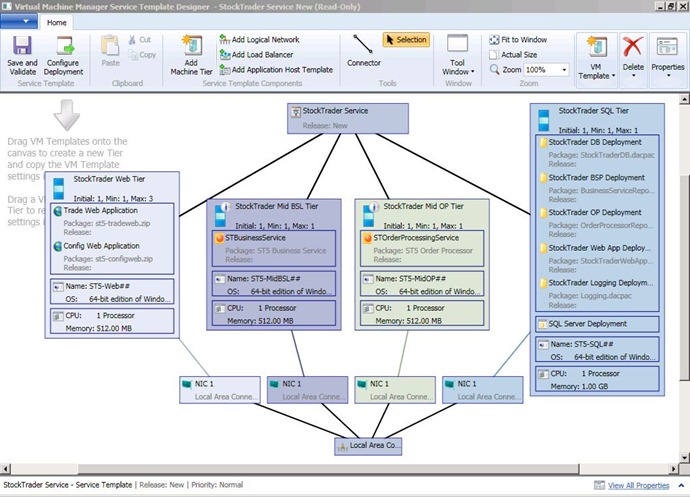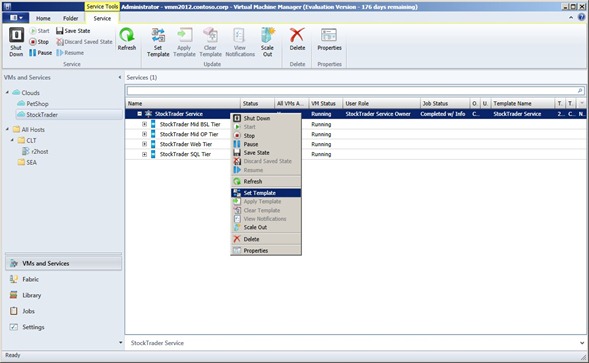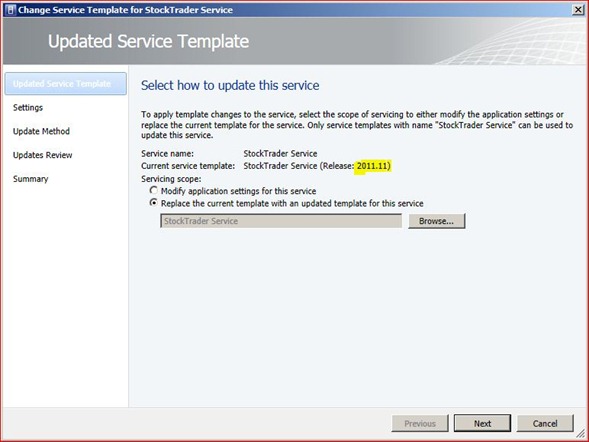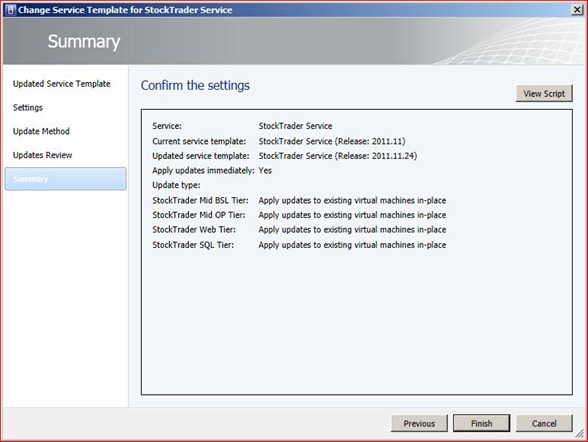System Center Virtual Machine Manager (VMM) 2012 as Private Cloud Enabler (4/5): Working with Service Templates
A key feature delivered by VMM 2012 is the ability to deploy an application based on a service template which enables a push-button deployment of a target application infrastructure. VMM 2012 signifies a direct focus, embedded in product design, on addressing the entire picture of a delivered business function, rather than presenting fragmented views from individual VMs. VMM 2012 makes a major step forward and declares the quintessential arrival of IT as a Service by providing out-of-box private cloud product readiness for enterprise IT.
In this fourth article of the 5-part series on VMM 2012,
- Part 1. Private Cloud Concepts
- Part 2. Fabric, Oh, Fabric
- Part 3. Deployment with Service Template
- Part 4. Working with Service Templates (This article)
- Part 5. App Controller
I further explain the significance of employing a service template.
This is in my view the pinnacle of VMM 2012 deliveries. The idea is apparent, to deliver business functions with timeliness and cost-effectiveness by standardizing and streamlining application deployment process. of Here I focus on the design and architectural concepts of a service template to help a reader better understand how VMM 2012 accelerates the process of a private cloud with consistency, repeatability, and predictability. The steps and operations to deploy and administer a private cloud with a service template will be covered in upcoming screencasts as supplements to this blog post series.
The term, service, in VMM 2012 means a set of VMs to be configured, deployed, and managed as one entity. And a service template defines the contents, operations, dependencies, and intelligence needed to do a push-button deployment of an application architecture with a target application configured and running according to specifications. This enables a service owner to manage not only individual VMs, but the business function in its entirety delivered as a (VMM 2012) service. Here, for instance, a service template developed for StockTrader is imported and displayed in the Service Template Designer of VMM 2012 as below revealing
- Four VM templates to construct a four-tier application architecture with web front-end, business service layer, operations, and SQL back-end
- Each VM template specifying how to compose and instantiate an intended VM operationally including specifications of virtualization platforms, RAM, OS, product key, domain, local admin credentials, networking, application virtualization packages to be installed/configured, and the associated timing, procedures, and operations
Application Deployment as Service via IaaS
Since VMM 2008, Microsoft has offered private cloud deployed with IaaS. Namely a self-service user can be authorized with the ability to provision infrastructure, i.e. deploy VMs to authorized environment, on demand. While VMs can be deployed on demand, what is running within those VMs when and how is however not a concerned of VMM 2008.
VMM 2012 on the other hand is designed with service deployment and private cloud readiness in mind. In addition to deploying VMs, VMM 2012 can now deploy services. As mentioned earlier, a service in VMM 2012 is an application delivered by a set of VMs which are configured, deployed, and maintained as one entity. More specifically, VMM 2012 can deploy on demand not only VMs (i.e. IaaS), but VMs collectively configured as an instance of a defined application architecture for hosting a target application by employing a service template. As VMs are deployed, an instance of a defined application architecture is automatically built, and a target application hosted in the architecture becomes functional and available. VMM 2012 therefore converts an application deployment into a service via IaaS.
The Rise of Service Architect
 Importantly, a service template capturing all relevancies of an application deployment is an integral part of the application development and production operations. A seasoned team member (whom I call Service Architect) with a solid understanding of application development and specifications, private cloud fabric construction, and production IT operations is an ideal candidate for authoring service templates.
Importantly, a service template capturing all relevancies of an application deployment is an integral part of the application development and production operations. A seasoned team member (whom I call Service Architect) with a solid understanding of application development and specifications, private cloud fabric construction, and production IT operations is an ideal candidate for authoring service templates.
Context and Operation Models
In a private cloud setting, enterprise cloud admin constructs fabric, validates service templates, and acts as a service provider. Service owners are those self-service users authorized to deploy services to intended private clouds using VMM 2012 admin console and act as consumers. Therefore, while enterprise IT constructs fabric and validates service templates, a service owner deploys services based on authorized service templates to authorized private clouds on demand. Notice a self-service user can access authorized templates and instances of VMs and services, private clouds, VM instances, etc. A self-service users nevertheless does not see the private cloud fabric in VMM 2012 admin console or App Controller.
Setting the context at an application level, a service owner deploys a service based on an authorized service template to an authorized private cloud on demand. And here a service owner acts as a service provider. At the same time, an authorized end user can access the application’s URL and acts as a consumer. In this model, an end user does not know and there is no need to know how the application is deployed. As far as a user is concerned, the user experience of accessing a private cloud is similar to accessing a web application.
Standardization, Consistency, Repeatability, and Predictability
What are specified in a service template including static definitions and pre-defined criteria of the what, how, when, and inter-dependency and event-driven information to automate the deployment process of an application. To be able to deploy an application multiple times with the same service template in the same environment, there is also instance information like machine names which are generated, validated, and locked down by VMM 2012 right  before deployment when clicking Configure Deployment from Service Template Designer. The separation of instance information from static variables and event-driven operations among VMs of an application included in a service template offers an opportunity to standardize a deployment process with consistent configurations, repeatable operations, and predictable outcomes.
before deployment when clicking Configure Deployment from Service Template Designer. The separation of instance information from static variables and event-driven operations among VMs of an application included in a service template offers an opportunity to standardize a deployment process with consistent configurations, repeatable operations, and predictable outcomes.
 Service Template is in essence a cookie cutter which can reproduce content according to predefined specifications, in this case the shape of a cookie. A service based on a VMM 2012 service template can deployed multiple times on the same fabric, i.e. the same infrastructure, by validating the instance information in each deployment. This is similar to using the same cookie cutter with various cookie dough. The instances are different, the specifications are nonetheless identical.
Service Template is in essence a cookie cutter which can reproduce content according to predefined specifications, in this case the shape of a cookie. A service based on a VMM 2012 service template can deployed multiple times on the same fabric, i.e. the same infrastructure, by validating the instance information in each deployment. This is similar to using the same cookie cutter with various cookie dough. The instances are different, the specifications are nonetheless identical.
Upgrading Service
Deployment with a service template can greatly simplify an upgrade scenario of an already deployed application. First, the production application infrastructure of StockTrader can be realistically and relatively easily mimicked in a test environment by configuring and deploying the same service template to a private cloud for development, such as an isolated logical network of 192.168.x.x subnet defined in the Network pool of the private cloud fabric. in VMM 2012. A new release, 2011.11.24 for example, of the application based on a service template (Release 2011.11) can then be developed and tested in this development environment.
Once the development process is concluded and the service template of Release 2011.11.24 is ready to be deployed, a cloud administrator can then import the service template and associated resources, as applicable, into the private cloud fabric, followed by validating the resource mapping so all references in Release 2011.11.24 are pointing to those in production. To upgrade an application from Release 2011.11 to Release 2011.11.24 at this point is simply a matter of applying the production instance to the service template of Release 2011.11.24. It is quite straightforward form VMM 2012 admin console by right-clicking the instance to be upgrades and setting a target template as show below.
This process is wizard-driven. Depending on how an application’s upgrade domain is architected, current application state, and the natures of changes, application outage may or may not be necessary. The following highlights a process of replacing a service template from Release 2011.11 to Release 2011.11.24 on an instance of StockTrader service.
There are different ways that a new service template can be applied to a running instance. For an authorized self-service user, the above process can also be easily carried out with App Controller, which I will detail in Part 5 of this blog post series.
Retiring Service
In VMM 2012, deleting a running service will stop and erase all the associated VM instances. Nevertheless, the resources referenced in the service template are still in place. To delete a service template, all configure deployments and deployed instances must be deleted first.
Archiving Services
As private clouds are built and services are deployed, releases of services can be documented by archiving individual service templates with associated resources. Notice this is not about backing up instances and data associated with the instances of an application, but to as preferred keep records of all resources, configurations, operations, and intelligence needed to successfully deploy the application.
Closing Thoughts
 With the maturity of virtualization and introduction of cloud computing, IT is changing with an increasing speed and the industry is transforming as we speak. VMM 2012 essentially substantiates the arrival of IT as a Service in enterprise IT. While the challenges are overwhelming, the opportunities are at the same time exciting and extraordinary. IT professionals should not and must not hesitate anymore, but get started on private cloud and get started now. Be crystal clear on what is cloud and why virtualization is far from cloud. Do master Hyper-V and learn VMM 2012. And join the conversation and take a leading role in building private cloud. With the strength of a new day dawning and the beautiful sun, there is no doubt in my mind that a clear cloudy day is in sight for all of us.
With the maturity of virtualization and introduction of cloud computing, IT is changing with an increasing speed and the industry is transforming as we speak. VMM 2012 essentially substantiates the arrival of IT as a Service in enterprise IT. While the challenges are overwhelming, the opportunities are at the same time exciting and extraordinary. IT professionals should not and must not hesitate anymore, but get started on private cloud and get started now. Be crystal clear on what is cloud and why virtualization is far from cloud. Do master Hyper-V and learn VMM 2012. And join the conversation and take a leading role in building private cloud. With the strength of a new day dawning and the beautiful sun, there is no doubt in my mind that a clear cloudy day is in sight for all of us.



